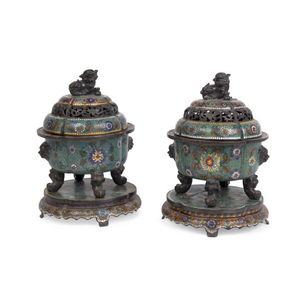Pair of Qing Dynasty Bronze Censers with Covers
Two bronze censers and covers Qing Dynasty comprising an unusual incense clock of squat bombe form supported on tripod cabriole legs and set with two loose ring handles, pierced domed cover; and a gold splashed ovoid censer, the flat cover pierced with scrolls (4) 16.6 cm high; 9 cm high
You must be a subscriber, and be logged in to view price and dealer details.
Subscribe Now to view actual auction price for this item
When you subscribe, you have the option of setting the currency in which to display prices to $Au, $US, $NZ or Stg.
This item has been sold, and the description, image and price are for reference purposes only.
- Bronze - An alloy of copper and tin, traditionally in the proportions of about 9 parts of copper to 1 part of tin.
The discovery of bronze in Western Asia in the 4th century enabled people to create metal objects which were superior to those previoulsy possible because of its strength and hardness, and it has been used throughout the world for weapons, coins, tools, statuary and other decorative items.
It is very fluid in a molten state, and its hardness, strength when set, and non-corrosive properties makes it most suitable for casting sculpture. - Oviform /ovoid - The outline loosely resembling the shape of an egg.
- Qing Dynasty - The Qing Dynasty was the last imperial dynasty of China, ruling from 1644 to 1912. It was established by the Manchu people, who originated from the northeastern region of China. The Qing Dynasty was preceded by the Ming Dynasty and followed by the Republic of China.
- Ming Dynasty - The Ming Dynasty was a ruling dynasty of China from 1368 to 1644. It succeeded the Yuan Dynasty and preceded the Qing Dynasty. The Ming Dynasty was established by Zhu Yuanzhang, a former Buddhist monk who became a rebel leader and eventually overthrew the Mongol Yuan Dynasty. During the Ming Dynasty, China experienced a period of relative stability and prosperity. The government was centralized and bureaucratic, with the emperor at the top of the hierarchy. The Ming Dynasty is known for its cultural achievements, including the development of porcelain, the invention of movable type printing, and the construction of the Great Wall of China.
This item has been included into following indexes:
Visually similar items

19th century Royal Worcester ivory ground, hand gilt and painted pot pourri with pierced lid
Sold by
in
for
You can display prices in $Au, $US, $NZ or Stg.

Doulton Lambeth water filter, 36 cm high
Sold by
in
for
You can display prices in $Au, $US, $NZ or Stg.

Early 19th century gravy tureen on fixed stand and lidded, blue ground with floral cartouches - possibly Coalport
Sold by
in
for
You can display prices in $Au, $US, $NZ or Stg.

A pair of large Chinese cloisonne censers, late 19th century/early 20th century, 37 cm high. Provenance: Property of a Gentleman, Melbourne
Sold by
in
for
You can display prices in $Au, $US, $NZ or Stg.
